
Table of Contents
INTRODUCTION............................................... 2
Machine Description ...................................... 2
Contact Info.................................................... 2
Manual Accuracy ........................................... 2
Identification ................................................... 3
Basic Controls ................................................ 4
Machine Data Sheet ...................................... 5
SECTION 1: SAFETY....................................... 7
Safety Instructions for Machinery .................. 7
Additional Safety for Mill/Drills ....................... 9
SECTION 2: POWER SUPPLY ...................... 10
Availability .................................................................10
Full-Load Current Rating ...........................................10
Circuit Requirements for 220V ..................................10
Grounding Instructions ..............................................11
Extension Cords ........................................................11
SECTION 3: SETUP ....................................... 12
Unpacking .................................................... 12
Needed for Setup ......................................... 12
Inventory ...................................................... 12
Cleanup ........................................................ 13
Site Considerations ...................................... 14
Lifting & Placing ........................................... 15
Bench Mounting ........................................... 15
Assembly ..................................................... 16
Joining Drill Chuck & Arbor .......................... 16
Lubricating Mill/Drill ...................................... 17
Test Run ...................................................... 17
Spindle Bearing Break-In ............................. 19
Inspections & Adjustments .......................... 19
SECTION 4: OPERATIONS ........................... 20
Operation Overview ..................................... 20
Downfeed Controls ...................................... 21
Identification ..............................................................21
Using Coarse Downfeed ...........................................21
Using Fine Downfeed ................................................21
Depth Stop ................................................... 21
Headstock Movement .................................. 22
Raising/Lowering Headstock .....................................22
Tilting Headstock .......................................................22
Table Travel ................................................. 23
Graduated Dials ........................................................23
X-Axis Handwheel .....................................................23
Y-Axis Handwheel .....................................................23
X-Axis Power Feed ...................................................24
Installing/Removing Tooling ......................... 24
Installing Tooling .......................................................25
Removing Tooling .....................................................25
Spindle Speed.............................................. 26
Determining Spindle Speed ......................................26
Setting Spindle Speed ...............................................26
Tapping Mode .............................................. 27
SECTION 5: ACCESSORIES ......................... 28
SECTION 6: MAINTENANCE......................... 30
Schedule ...................................................... 30
Cleaning and Protecting .............................. 30
Lubrication ................................................... 30
Headstock .................................................................31
Ball Oilers ..................................................................32
Table & Column Ways ..............................................32
Quill Outside Surface ................................................33
Table Leadscrews .....................................................33
Column Leadscrew, Nut, & Pinion Gear ...................34
Quill Rack & Pinion ...................................................34
SECTION 7: SERVICE ................................... 35
Troubleshooting ........................................... 35
Adjusting Gibs .............................................. 37
Adjusting Leadscrew Backlash .................... 37
Tightening Return Spring Tension ............... 38
SECTION 8: WIRING...................................... 39
Wiring Safety Instructions ............................ 39
Electrical Box & Control Panel Wiring ......... 40
Motor & Tapping Switches Wiring ............... 42
SECTION 9: PARTS....................................... 43
Headstock .................................................... 43
Table & Column ........................................... 46
Electrical ...................................................... 48
Accessories .................................................. 49
Labels & Cosmetics ..................................... 50
WARRANTY & RETURNS ............................. 53



















































